South Carolina Birds That Feed on Fish
Many people pride themselves on their capabilities as hunters. These men and women spend significant amounts of time honing their skills to track and catch prey. Of these hunting enthusiasts, some prefer to pit their skills against all manner of fish. Whether it's fly fishing along a stream or fishing in the open ocean, fishing is a major industry and pastime. While some people qualify as great anglers, even the best anglers pale in comparison next to the best animals. Animals that target fish evolved unique adaptations to help them catch fish, including claws, beaks, and fast reflexes. Among the best of these animals are the numerous birds that eat fish. With their keen eyesight and swiftness in the air or water, birds can catch fish in droves. Eagles, gulls, ducks, herons, storks, cormorants, ospreys, and penguins all eat fish, but how do they do it?
In this article, we'll cover 7 different birds that eat fish. We'll discuss where they live and also what they look like. In addition, we'll examine how they eat fish and what makes them such great hunters. Hopefully, you'll get to see one of these birds in action as it dives in for a meal. Let's get started learning about 7 birds that eat fish.
#7: Bald Eagle

The bald eagle is a sea eagle in the family Accipitridae. Found only in North America, the bald eagle lives near open bodies of water located between Alaska and Mexico. As the national bird of the United States, the bald eagle is one of the most recognizable birds in the world. It gets its name from its white head, which stands in stark contrast to its mostly dark brown plumage. On average, they measure 28 to 40 inches long with a wingspan between 5 feet, 11 inches, and 7 feet, 7 inches. While once threatened with extinction due to the use of pesticides with DDT, bald eagles are once again thriving. Currently, the IUCN lists them as a species of Least Concern.
Bald eagles feed opportunistically on almost whatever they can get, including garbage. However, the bulk of their diet includes fish such as trout, salmon, and catfish. Of the birds that eat fish, the bald eagle is capable of taking down some of the biggest prey. While most fish measure around a foot long, they can carry fish nearly 34 inches long through the air. Typically, bald eagles feed on carrion that floats to the surface or dead fish from other animals. That said, they will also dive down from the sky and catch live fish with their talons. They then proceed to rip the fish appear with their talons, which possess ten times the grip strength of a person.
#6: Common Tern
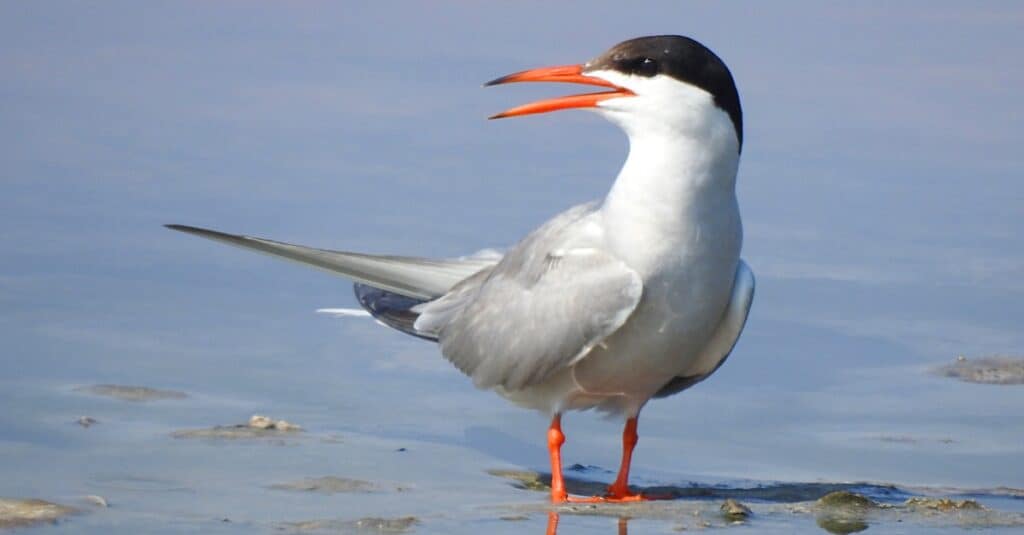
iStock.com/YanLev
The common tern belongs to the seabird family Laridae. Like other terns, it is strongly migratory and flies south during winter. In summer, it lives in temperate and subarctic regions of North America, Europe, and Asia. During winter, terns will migrate south to warmer coastal regions in South America, Africa, and Australia. Most common terms sport a black cap, white cheeks, neck, and underparts, and a gray back and wings. On average, they measure 12 to 14 inches long and sport webbed feet. Their bills appear quite long and change from orange in the back to black at the front. They nest in large colonies that can contain tens of thousands of birds, especially populations near the coasts.
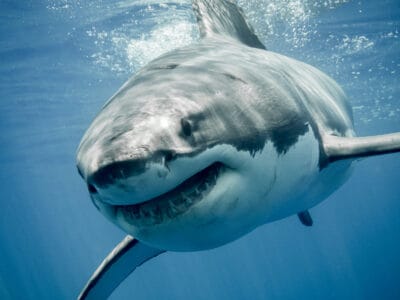
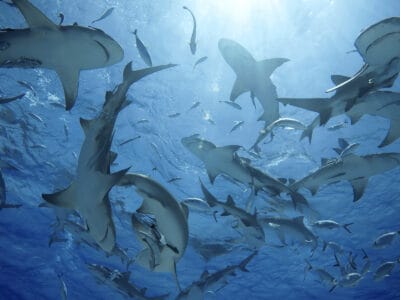
Common terns are birds that eat fish primarily, although they'll also eat insects, worms, squids, and crustaceans. They hunt by plunging headfirst into the water from heights up to 20 above the water surface. However, they do not dive deeply, and will only dive around 2 feet below the water surface before returning. The fish most often targeted by common terns measure around 2 to 6 inches long, such as sardines. Common terns will feed in flocks, and may also steal fish from other birds. Upon catching a fish, a common term will swallow it whole or carry it back to its nest.
#5: Great Blue Heron
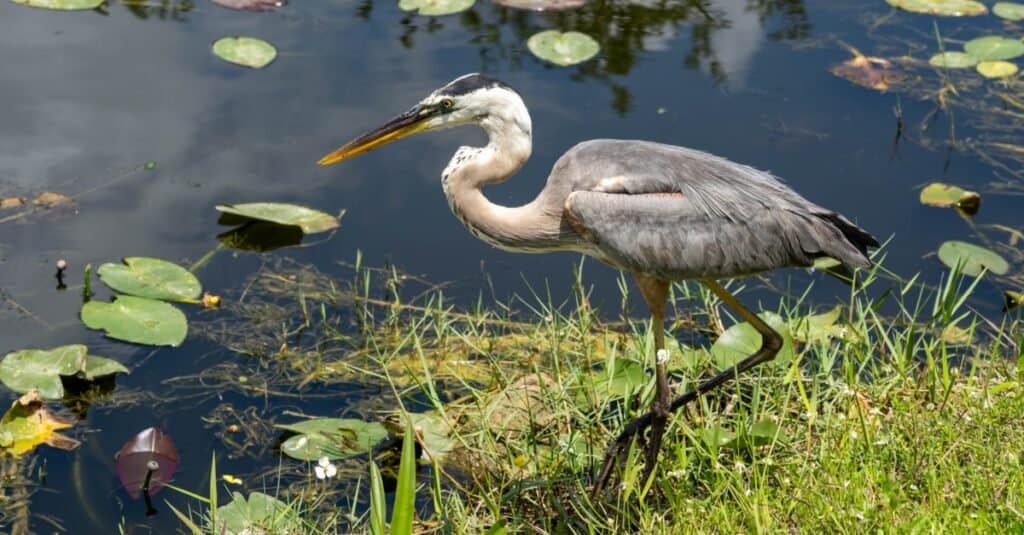
The great blue heron is a wading bird in the heron family Ardeidae. While most live in North America, you can also find them in the Galapagos Islands and the Caribbean. They live in a variety of wetland habitats, including lakes, marshes, and streams. Of all the herons in North America, the great blue heron clearly ranks as the largest. On average, they measure 36 to 54 inches long with a wingspan between 66 to 79 inches. They get their name from their large size and distinctive plumage. Their plumage appears blue-gray on the back and wings, light gray on the neck, and white and black on the front. Like all herons, great blue herons possess a long bill, which appears yellowish-orange.
Unlike some birds that eat fish in groups, great blue herons are solitary, and primarily hunt alone. Along with fish, they eat a wide variety of prey including crustaceans, insects, rodents, frogs, and reptiles such as snakes. The type of fish they consume differs depending on the region where they live. That said, common fish include flounder, perch, bass, smelt, and sticklebacks. Great blue herons typically hunt fish by standing very still near the edge of the water. However, they can also catch fish while walking or flying. They rely on their keen eyesight to spot prey and then lunge forward with their long bills. Upon catching a fish, a great blue heron will swallow it whole.
#4: Osprey
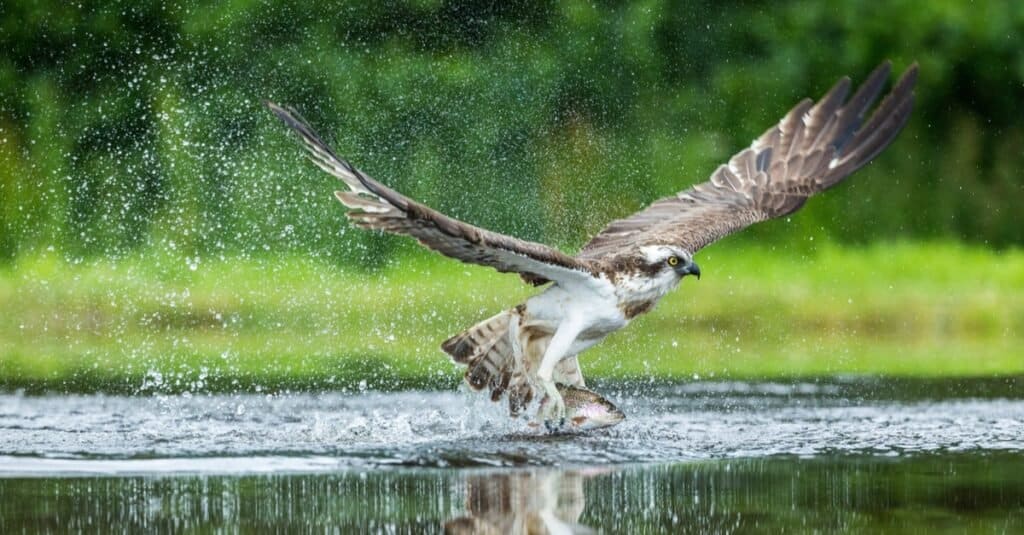
LMIMAGES/Shutterstock.com
Also known as the fish hawk, the osprey is a bird of prey in the family Pandionidae. The term osprey is often used to refer to the western osprey, as opposed to the eastern osprey. Together, these two birds make up the osprey family, although scientists also recognize several subspecies. Ospreys range throughout every continent except Antarctica, making them the most widely distributed raptor after the peregrine falcon. They live in a wide variety of habitats, although they tend to stay close to bodies of water. On average, they measure around 19.5 to 26 inches long and sport a wingspan between 50 to 71 inches. Their plumage appears dark brown on their back and wings, and white on their breast, head, and underparts.
Ospreys rank among the birds that eat fish almost exclusively. In total, fish make up 99% of its diet. That said, they will occasionally eat small mammals or birds if readily available. They will eat almost any fish that they can catch, which includes all fish weighing less than 4.5 pounds. While hunting, ospreys rely on their keen vision to spot fish from their air. Upon sighting a target, an osprey will dive down and plunge its feet into the water. Depending on how deep the fish is, an osprey may fully submerge itself beneath the water surface. Upon catching a fish, most ospreys will carry their prey back to a spot where they can sit and eat it.
#3: Great Cormorant
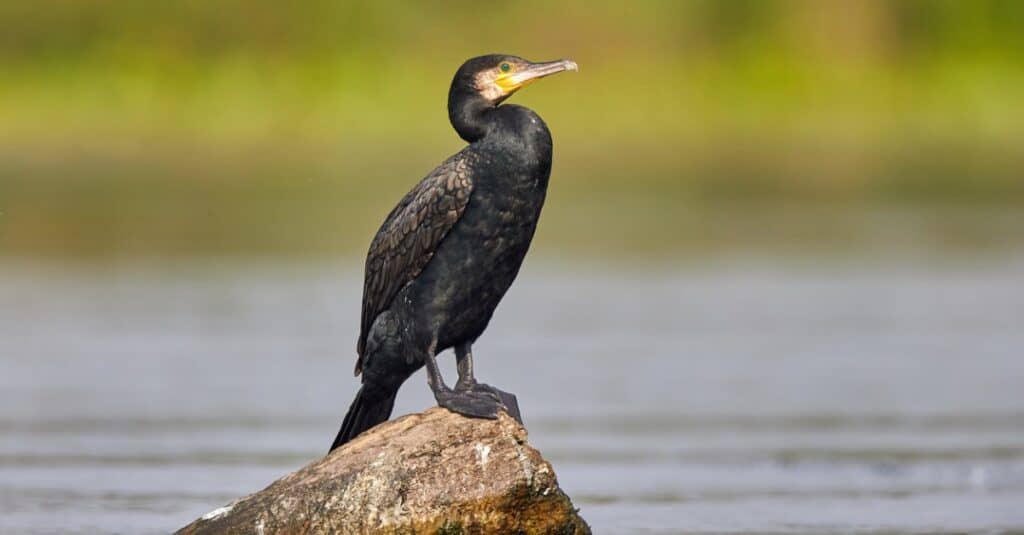
iStock.com/Richard Constantinoff
The great cormorant is a member of the cormorant family Phalacrocoracidae. Depending on the region where it lives, the great cormorant goes by many other names. Other names include the black shag, black cormorant, and large cormorant. Great cormorants are quite widespread and live in various wetland habitats including coastal areas, lakes, and rivers. You can find them in the eastern United States, Greenland, Europe, West and East Africa, Central and Southeast Asia, and Australia. Generally, great cormorants measure 27.5 to 40 inches with a wingspan of 47.5 to 63 inches. Their plumage appears predominantly black, with yellow throat patches on the throat.
Great cormorants hunt for fish by diving into the water. Among birds that eat fish, the cormorant uses similar tactics to diving ducks. They dive beak-first into the water and may stay submerged for up to 30 seconds. During that time, they dive to depths up to 19 feet below the water surface. While in water, they rely on both sight and their sensitive underwater hearing to find fish. Common fish that great cormorants eat include smelts, soles, and wrasses. Upon capturing a fish, a great cormorant will typically swallow the fish whole.
#2: Shoebill Stork
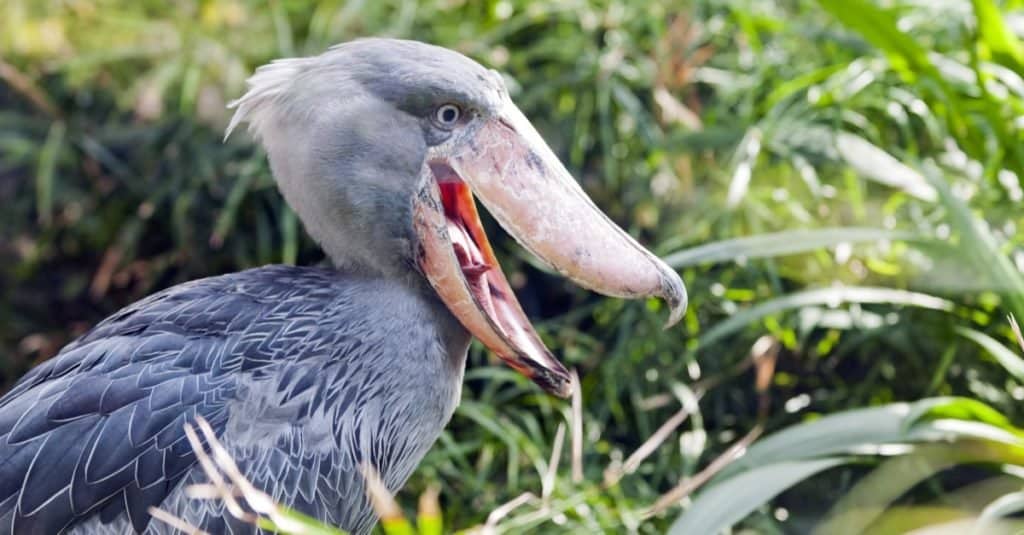
Nazzu/Shutterstock.com
Also known as the whalehead stork, the shoebill stork is one of the most unusual-looking birds that eat fish. Despite its name, the shoebill stork is actually a member of the heron and pelican order Pelecaniformes. The shoebill stork is the only member of its family Balaenicipitdae, which makes it one of the most unique birds in the world. Shoebill storks only live in wetlands such as bogs and marshes in Sub-Saharan Africa. Typically, they measure 39 to 55 inches long and sport a wingspan between 7 feet, 7 inches, and 8 feet, 6 inches. Their plumage appears blue-gray, with darker blue feathers near the edges of the wings. They get their name from their distinctive bill, which is thick and the third-longest of all extant birds. Unfortunately, due to habitat loss and poaching the shoebill stork is listed as Vulnerable by the IUCN.
Shoebill storks primarily eat fish, although they will also eat other aquatic animals including frogs, snakes, and other vertebrates. In particular, they prey upon several species of lungfish, bichir, tilapia, and catfish. Due to their large, sharp beaks, shoebill storks can hunt large prey measuring up to 3.3 feet long. While hunting, shoebill storks stand extremely still and wait for their prey to come within striking distance. Once they spot a fish with their keen vision, they will lash out with their bills and catch prey. Depending on the size, they typically swallow prey whole, although they may also bite it into smaller pieces.
#1: Emperor Penguin
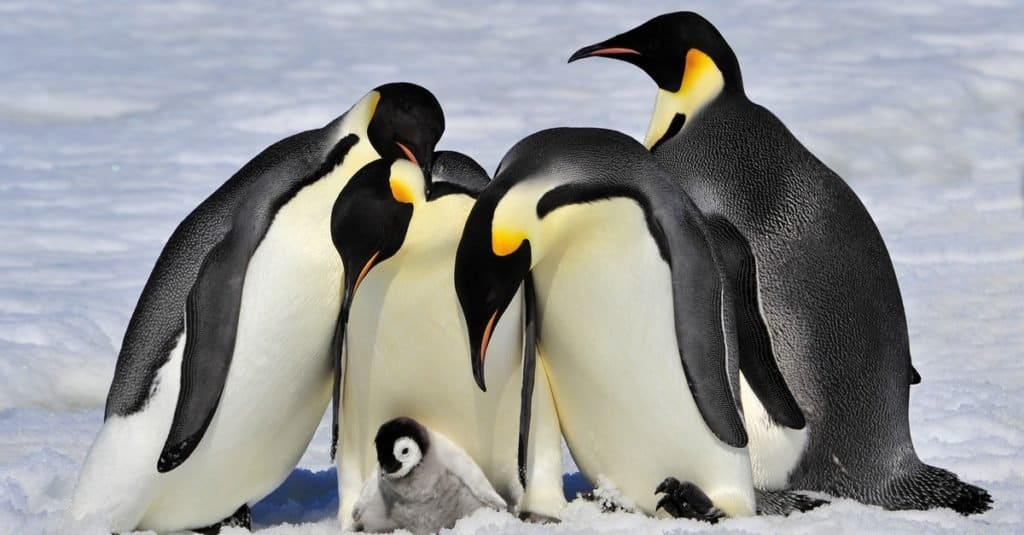
vladsilver/Shutterstock.com
The emperor penguin is a member of the penguin family Spheniscidae. It is the largest member of the penguin family, and one of the most recognizable birds that eat fish. Emperor penguins are native to Antarctica and live near the coasts. Due to changes in the landmass during the summer and winter, emperor penguins migrate a great distance over land as they follow the moving coastline. On average, emperor penguins measure 39 inches long and weigh between 49 to 99 pounds. Their plumage appears black on the back, white on the front, and yellow on the neck. Due to climate change, the IUCN currently lists the emperor penguin as a Near Threatened species.
Like other penguins, emperor penguins cannot fly. However, that does not stop them from effectively hunting for fish in the water. Emperor penguins can dive to depths up to 1,755 feet below the water surface. They can hold their breath for nearly 20 minutes while searching for food, and swim up to 5.6 miles per hour. While their diet also includes squids, crabs, and shrimp, emperor penguins primarily consume fish. In particular, they eat a large amount of Antarctic silverfish and cod. During a single dive, an emperor penguin may catch several fish before it returns to the surface.
Thank you for reading! Have some feedback for us? Contact the AZ Animals editorial team.
Source: https://a-z-animals.com/blog/7-birds-that-eat-fish/
0 Response to "South Carolina Birds That Feed on Fish"
Enregistrer un commentaire